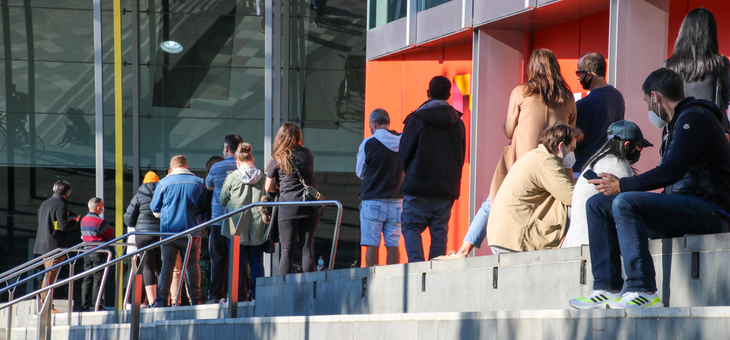There are 38 countries in the OECD and Australia is ranked 38th in terms of vaccination rates. And they’re going backwards.
That’s the finding of business consulting company Provocate, which says that Australia’s vaccination rates went backwards during June. To meet the Federal Budget’s vaccination and border targets, the ‘magic number’ of required daily jabs now sits at 221,359 – or nearly double current rates, it says.
That would deliver 48.1 million shots by the end of 2021, covering 85 per cent of the population with two doses – the same level of herd immunity being worked towards in the US and UK.
However, Provocate reveals that our vaccination rate averaged just 113,000 jabs per day in June.
“This has left the country over four million jabs behind the 12.4 million vaccinations Australia needed to have administered at this point in the rollout to meet the Federal Budget’s end of 2021 target, just seven weeks after it was extended from an October 2021 completion,” said Provocate managing director Troy Bilsborough.
Read more: Researchers zero in on AstraZeneca ‘quick fix’
And with extra Pfizer shots not being widely available until the end of July, Australia will likely need to average at least 300,000 vaccinations every day from 1 October – triple current rates – to catch up, he said.
Mr Bilsborough, a former senior adviser to the federal government ministers, said the more “realistic” scenario was that Australia’s vaccine rollout would be completed somewhere closer to March 2022 and that international travel would reopen next September.
As major airlines consider ceasing operations ‘down under’ with international arrival caps slashed, Mr Bilsborough said: “The constant political volatility upending Australia’s vaccine rollout risks gaslighting the very businesses governments are relying on to drive the country’s economic recovery out of COVID-19.
“Our closest allies in the US and UK have already set the bar at 85 per cent herd immunity, so Australia can’t afford a ‘magic number’ any lower if it wants to maintain business, public and political confidence.
“Australia’s time would be better spent picking up the phone and going cap in hand to our closest allies … to get as many spare vaccine doses as we can now.”
Britain recently announced 85 per cent of its adult population had received at least one COVID-19 jab, while US officials had upgraded their herd immunity expectations from 60-70 per cent to 85 per cent.
As of Wednesday, 7.57 per cent of the Australian population – or 1.88 million people – had been fully vaccinated and 25.14 per cent had received one dose.
Read more: Why is the Delta variant such a worry?
As the highly contagious Delta variant takes hold in many parts of the world, including in Australia, UK health authorities have opted to reduce the interval between AstraZeneca vaccines from 12 to eight weeks for people aged 40 and over.
“The Delta variant has changed the environment for vaccines in the UK,” said that country’s deputy chief medical officer Jonathan Van-Tam. “We now know that two doses of vaccine are very much better than one dose for protection against infection with the Delta variant.”
Australian clinical epidemiologist Professor Terry Nolan said the concern was that the Delta variant was much more transmissible and possibly more severe and more likely to result in hospitalisation.
The ABC reports that a study published earlier this year in The Lancet found a single dose of AstraZeneca was 76 per cent effective in the first 90 days. Receiving a second dose 12 weeks or more after the first lifted this protection to 82.4 per cent. However, efficacy dropped to around 55 per cent if the second jab was given less than six weeks after the first.
Treasurer Josh Frydenberg said on Wednesday that the federal government had identified a number of “really good opportunities” to work with businesses to speed up the vaccine rollout as more doses arrived in coming months.
“Whether it’s offering premises, helping with logistics, communication strategies, community engagement,” he said.
The possibility of rolling out ‘incentives’ to encourage workers to roll up their sleeves was being discussed, he said.
“Our guiding principle to date has been that the vaccination has been voluntary. But we want as many people as possible to take it and the more people who do, the stronger our nation will be at beating off the virus.”
Read more: Australia’s four-phase COVID-normal plan
University of New South Wales epidemiologist Professor Mary-Louise McLaws, an adviser to the World Health Organization, has warned a third jab may be required before Australians can travel overseas again.
She told 7-News: “With more research done and as we’re learning more about COVID-19, it would appear we need a third shot, preferably around eight months.
“It’s a bit like the flu, in that we have a new flu shot each year because of the way it might change, and there’s something called shift and drift.
“The way that the virus changes, and some years, it doesn’t work well (like) last year’s influenza shot, and the same thing may happen with this one.”
Have you asked about having a second AstraZeneca shot after eight weeks because of the extent of the Delta variant? Share your experiences in the comments section below.
If you enjoy our content, don’t keep it to yourself. Share our free eNews with your friends and encourage them to sign up.

